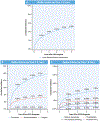Incidence, Treatment, and Outcomes of Symptomatic Device Lead-Related Venous Obstruction
- PMID: 37204378
- PMCID: PMC10330837
- DOI: 10.1016/j.jacc.2023.04.017
Incidence, Treatment, and Outcomes of Symptomatic Device Lead-Related Venous Obstruction
Abstract
Background: The incidence and clinical impact of lead-related venous obstruction (LRVO) among patients with cardiovascular implantable electronic devices (CIEDs) is poorly defined.
Objectives: The objectives of this study were to determine the incidence of symptomatic LRVO after CIED implant; describe patterns in CIED extraction and revascularization; and quantify LRVO-related health care utilization based on each type of intervention.
Methods: LRVO status was defined among Medicare beneficiaries after CIED implant from October 1, 2015, to December 31, 2020. Cumulative incidence functions of LRVO were estimated by Fine-Gray methods. LRVO predictors were identified using Cox regression. Incidence rates for LRVO-related health care visits were calculated with Poisson models.
Results: Among 649,524 patients who underwent CIED implant, 28,214 developed LRVO, with 5.0% cumulative incidence at maximum follow-up of 5.2 years. Independent predictors of LRVO included CIEDs with >1 lead (HR: 1.09; 95% CI: 1.07-1.15), chronic kidney disease (HR: 1.17; 95% CI: 1.14-1.20), and malignancies (HR: 1.23; 95% CI: 1.20-1.27). Most patients with LRVO (85.2%) were managed conservatively. Among 4,186 (14.8%) patients undergoing intervention, 74.0% underwent CIED extraction and 26.0% percutaneous revascularization. Notably, 90% of the patients did not receive another CIED after extraction, with low use (2.2%) of leadless pacemakers. In adjusted models, extraction was associated with significant reductions in LRVO-related health care utilization (adjusted rate ratio: 0.58; 95% CI: 0.52-0.66) compared with conservative management.
Conclusions: In a large nationwide sample, the incidence of LRVO was substantial, affecting 1 of every 20 patients with CIEDs. Device extraction was the most common intervention and was associated with long-term reduction in recurrent health care utilization.
Keywords: Medicare; cardiovascular implantable electronic devices; health care utilization lead extraction; lead-related venous obstruction; percutaneous revascularization.
Copyright © 2023 American College of Cardiology Foundation. Published by Elsevier Inc. All rights reserved.
Conflict of interest statement
Funding Support and Author Disclosures Dr Secemsky is supported in part by K23HL150290; and receives consulting fees from Abbott, Bayer, BD, Boston Scientific, Cook, CSI, Medtronic, Philips, Shockwave, and VentureMed. Dr Kramer is supported by R01HL161697 and R01AG068141. Dr Carroll has received institutional research support from Bristol Myers Squibb; and has received consulting fees from Janssen. Dr Yeh has received research funding and consulting fees from Abbott Vascular, Boston Scientific, and Medtronic; and has received research funding from Bard, Cook, and Philips. All other authors have reported that they have no relationships relevant to the contents of this paper to disclose.
Figures




Comment in
-
Cardiovascular Implantable Electronic Devices: Less Is (Often) More.J Am Coll Cardiol. 2023 Jun 20;81(24):2341-2343. doi: 10.1016/j.jacc.2023.05.004. J Am Coll Cardiol. 2023. PMID: 37316114 No abstract available.
References
Publication types
MeSH terms
Grants and funding
LinkOut - more resources
Full Text Sources
Medical

